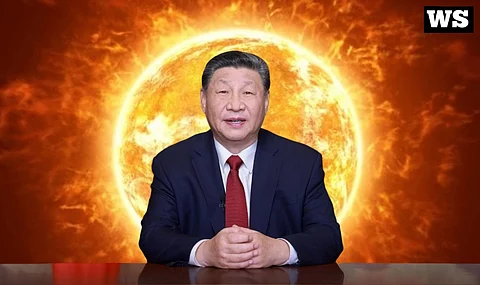

China has discovered an “endless” supply of a sun-like energy source that Beijing geologists say can provide enough energy to “power the country for 60,000 years.”
A trove of thorium, which is a slightly radioactive metal and can be used to create nuclear energy through a “molten-salt reactor,” has been discovered at the Bayan Obo mining complex in Inner Mongolia, an autonomous region of northern China.
China has been quietly eyeing up thorium as a replacement for nuclear energy made with uranium for some time now. Chinese President Xi Jinping in 2024 historically approved the world’s first thorium molten-salt reactor plant in the Gobi Desert, according to Nuclear Engineering International.
The amount of thorium now discovered is enough to meet China’s domestic energy demands “almost forever.”
Chinese scientists in a classified report obtained by the South China Morning Post say if fully exploited, the mine could produce up to a million tons of thorium.
The thorium resources “remain totally untouched" and, if extracted properly, its enormous quantity has the potential to eliminate dependence on fossil fuels worldwide.
A Beijing-based scientist on the condition of anonymity told the Hong Kong-based publication “every nation has thorium” that can be harnessed anytime and change the landscape of energy production and consumption.
“Imagine cargo ships powered by container-sized reactors crossing oceans for years without refuelling,” the geologist said.
“For over a century, nations have been engaging in wars over fossil fuels. It turns out the endless energy source lies right under our feet.”
Researchers indicate newly discovered reservoirs of thorium aren't localized to just the one mine — a total of 233 thorium-rich zones across Inner Mongolia have been documented, a significant increase to existing estimates.
The study reviewed by the Post further suggests there’s enough thorium leftover in Inner Mongolia to meet all American energy demands for more than 1,000 years after a mere five years worth of mining.
The process of producing nuclear energy is called “fission,” where radioactive elements are reduced to small, stable elements that produce heat, per the US Department of Energy.
During this process, the element breaks down into smaller, more stable elements and releases heat which can be used to drive steam turbines.
Thorium is estimated to be 500 times more abundant than the uranium used in conventional nuclear reactors. It isn’t a “fissile” material, but it’s a “fissionable” one — meaning it requires high-energy neutrons for the fission process.
The International Atomic Energy Agency explains (IAEA) fission as “the splitting of atomic nuclei which releases energy that is used for electricity generation.”
“However, when irradiated, thorium-232 undergoes a series of nuclear reactions, eventually forming uranium-233, a fissile material that can be burned up as fuel in nuclear reactors,” says the IAEA.
Thorium has multiple advantages to its uranium cousin, not least of which is the fact it can produce more energy when fuelled by a water-cooled or molten-salt reactor, as is the case with Beijing’s innovation.
In such a nuclear reactor, thorium is mixed with lithium fluoride and heated to 1,400°C, which bombards the mixture with neutrons and transforms it into uranium —- which in turn produces even more neurons, and created heat that can be used as fuel.
This form of energy production also has significantly less waste than uranium nuclear power, is more abundant in the earth’s crust and can generate 200 times more energy than uranium, according to the World Nuclear Association.
Beijing’s thorium molten-salt reactor plant built in Gobi Desert last year, which is expected to be completed in 2029, will have a generating capacity of 10 megawatts of electricity, estimates Shanghai Nuclear Engineering Research and Design Institute.
The reactor is meant to secure China’s “energy independence,” said researchers.
